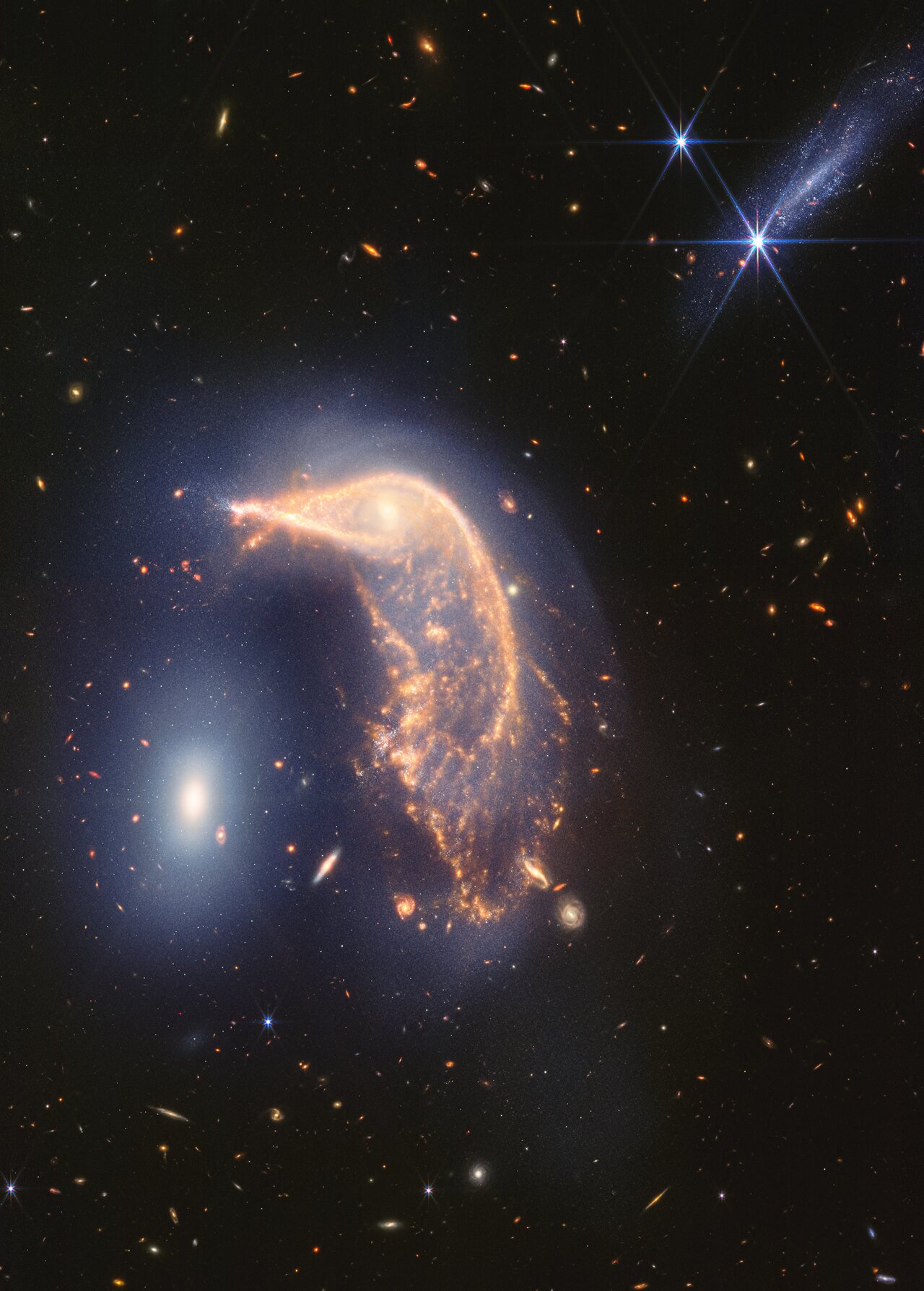About the Object
| Name: | Arp 142 | |
|---|---|---|
| Distance: |
326 million light years | |
| Constellation: | Hydra | |
| Category: | Anniversary Galaxies MIRI NIRCam | |
Coordinates
| Position (RA): | 9 37 43.03 |
|---|---|
| Position (Dec): | 2° 45' 24.02" |
| Field of view: | 2.23 x 3.11 arcminutes |
| Orientation: | North is 18.5° right of vertical |
Colours & filters
| Band | Wavelength | Telescope |
|---|---|---|
| Optical | 900 nm | James Webb Space Telescope NIRCam |
| Infrared | 1.5 μm | James Webb Space Telescope NIRCam |
| Infrared | 2.0 μm | James Webb Space Telescope NIRCam |
| Infrared | 2.77 μm | James Webb Space Telescope NIRCam |
| Infrared | 3.56 μm | James Webb Space Telescope NIRCam |
|
Infrared
PAH | 7.7 μm | James Webb Space Telescope MIRI |
| Infrared | 15 μm | James Webb Space Telescope MIRI |
|
Infrared
Silicate | 10 μm | James Webb Space Telescope MIRI |
| Infrared | 4.44 μm | James Webb Space Telescope NIRCam |
Interacting galaxies Arp 142 (NIRCam and MIRI image)
The distorted spiral galaxy at the centre, the Penguin, and the compact elliptical galaxy at the left, the Egg, are locked in an active embrace. A new near- and mid-infrared image from the James Webb Space Telescope, taken to mark its second year of science, shows that their interaction is marked by a faint upside-down U-shaped blue glow.
The pair, known jointly as Arp 142, made their first pass between 25 and 75 million years ago — causing ‘fireworks’, or new star formation, in the Penguin. In the most extreme cases, mergers can cause galaxies to form thousands of new stars per year for a few million years. For the Penguin, research has shown that about 100 to 200 stars have formed per year. By comparison, our Milky Way galaxy (which is not interacting with a galaxy of the same size) forms roughly six to seven new stars per year.
This gravitational shimmy also remade the Penguin’s appearance. Its coiled spiral arms unwound, and gas and dust were pulled in an array of directions, like it was releasing confetti. It is rare for individual stars to collide when galaxies interact (space is vast), but the galaxies’ mingling disrupts their stars’ orbits.
Today, the Penguin’s galactic centre looks like an eye set within a head, and the galaxy has prominent star trails that take the shape of a beak, backbone, and fanned-out tail. A faint, but prominent dust lane extends from its beak down to its tail.
Despite the Penguin appearing far larger than the Egg, these galaxies have approximately the same mass. This is one reason why the smaller-looking Egg hasn’t yet merged with the Penguin. (If one was less massive, it may have merged earlier.)
The oval Egg is filled with old stars, and little gas and dust, which is why it isn’t sending out ‘streamers’ or tidal tails of its own and instead has maintained a compact oval shape. If you look closely, the Egg has four prominent diffraction spikes — the galaxy’s stars are so concentrated that it gleams.
Now, find the bright, edge-on galaxy at top right. It may look like a party crasher, but it’s not nearby. Cataloged PGC 1237172, it lies 100 million light-years closer to Earth. It is relatively young and isn’t overflowing with dust, which is why it practically disappears in Webb’s mid-infrared view.
The background of this image is overflowing with far more distant galaxies. This is a testament to the sensitivity and resolution of Webb’s infrared cameras.
Arp 142 lies 326 million light-years from Earth in the constellation Hydra.
[Image description: Two interacting galaxies known as Arp 142. At left is NGC 2937, nicknamed the Egg for its appearance. At right is NGC 2936, nicknamed the Penguin for its appearance. The latter’s beak-like region points toward and above the Egg.]
Credit:NASA, ESA, CSA, STScI
About the Image
| Id: | weic2420a | |
|---|---|---|
| Type: | Observation | |
| Release date: | 12 July 2024, 16:00 | |
| Related releases: | weic2420 | |
| Size: | 4280 x 5977 px | |




